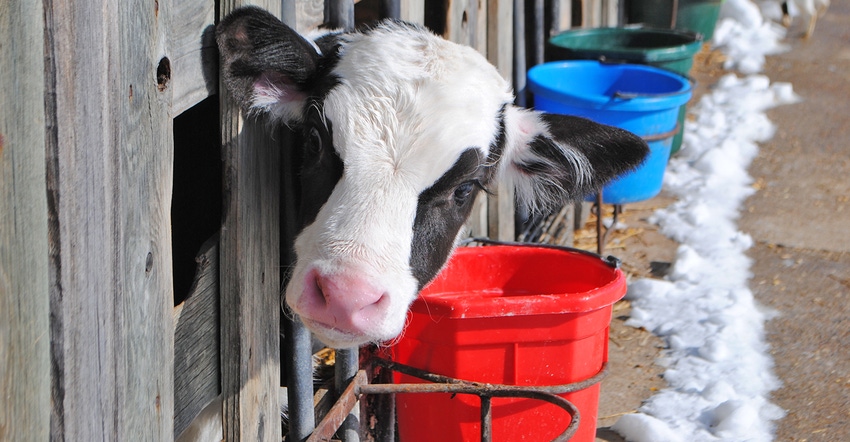October 5, 2018

By Tina Kohlman
It’s hard to believe we’re heading into winter months again. That means it’s time to prepare your calves for cold weather.
As a rule of thumb, if you need to wear a sweatshirt to do chores, temperatures are cool enough to turn your focus on a winter calf management program. The thermal neutral zone (comfort zone) for newborn calves is 50 to 78 degrees F, while 1-month-old calves’ thermal neutral zone is 32 to 78 degrees. Once the temperature reaches below the lower critical temperature of 32 degrees for 1-month-old calves or 50 degrees for newborn calves, the energy they consume is used for maintenance, making less available for growth and immune function.
Is it really that bad? See it from the calf’s perceptive. If a 100-pound calf has only 1.5 pounds of fat reserve at birth, this fat reserve can easily be depleted within 18 hours under certain conditions. For every 1-degree drop below the lower critical temperature, maintenance requirements increase 1%. If energy increase is not provided, calves have the potential to become sick or die.
Based on a USDA National Animal Health Monitoring System study, only 33% of dairy producers change calf-feeding practices in cold weather. Failure to minimize the effects of cold stress results in depressed immune function, increased risk of sickness, poor response to treatment, decreased growth performance and possible death.
A calf can stand a good deal of cold weather if it is dry and protected from drafts. To minimize cold stress, one area of focus is the calf’s environment. This includes the calf’s resting space, feeding area and walking surface. As temperatures begin to drop in fall, the following are ways to minimize cold stress:
• A dry, clean place to lie with plenty of bedding. Based on University of Wisconsin research, calves tend to lie down nearly 50% of the time during the day and 100% of the time at night. Wet bedding causes the calf’s hair coat to clump and lose insulation value. Ideal bedding provides a good base to soak up liquid, provide a buffer from the cold ground, provide insulation and allow the calf to nestle. Dairy Calf and Heifer Association Gold Standards recommend 6 to 12 inches or 20 to 25 pounds of bedding per calf to provide a good base. To maintain the base, 2 to 3 pounds of bedding per day should be added to the pen or hutch. The amount of bedding used is more important than the specific material used.
• Plenty of fresh air with minimal draft. UW School of Veterinary Medicine research shows that as temperatures fall, pneumonia incidences rise. Pneumonia can be attributed to cold stress and calves not meeting their energy needs to support their immune systems. Also, pneumonia can be attributed to poor air quality as producers close up barns during the winter. DCHA Gold Standard II indicates indoor ventilation rate should be 50 cubic feet per minute during mild weather and 15 cfm during cold weather to provide good air quality while minimizing cold air drafts.
• Blankets to help keep calves warm. North Dakota State University research shows calves wearing calf blankets during cold weather had 1.4 pounds of daily gain from birth to 4 weeks of age as compared to 1.2 pounds of gain by calves with no blanket. Blankets should fit properly and allow room for growth. Blankets should be dry. Monitor blanket use to minimize sweating or overheating, which would affect the insulation value of the calf’s hair coat.
• Minimum frost or condensation. During very cold weather, minimize frost or condensation to reduce bacterial growth in pens and the calving environment.
As you plan for this winter’s calf management program, don’t forget about the calves’ environment. Focus on comfort and cleanliness to help your calves thrive this winter season.
Kohlman is the Extension dairy and livestock agent in Fond du Lac County, Wis. This column is provided by the University of Wisconsin-Extension Dairy Team.
You May Also Like




